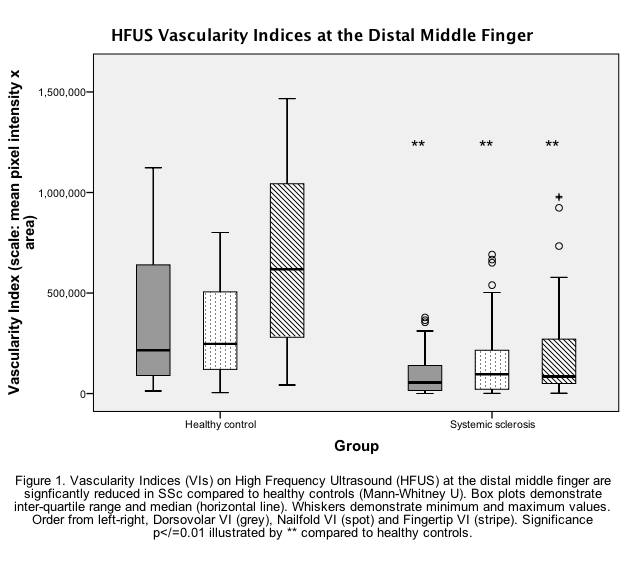Session Information
Date: Tuesday, October 23, 2018
Title: Systemic Sclerosis and Related Disorders – Clinical Poster III
Session Type: ACR Poster Session C
Session Time: 9:00AM-11:00AM
Background/Purpose:
Structural and functional vascular abnormalities occur in Systemic Sclerosis (SSc). We report on the use of High Frequency Ultrasound (HFUS) with Superb Microvascular Imaging (cSMI) as a novel approach to assessing digital vasculopathy in SSc.
Methods:
Fifty-three SSc (2013 ACR/EULAR criteria) and fifteen healthy controls (HC) underwent assessment of the distal middle finger using a novel Doppler cSMI modality, able to detect low velocity microvascular flow and simultaneously minimise motion artefact. HFUS cSMI was used to measure Vascularity Indices (VIs) at 3 regions of interest (Dorsovolar [DVVI], Nailfold [NVI] and Fingertip [FVI]). Morphological assessment of capillaries was undertaken using nailfold capillaroscopy (NC). Functional post-occlusive microvascular responses were assessed using Laser Speckle Contrast Imaging (LSCI). The Raynaud’s Condition Score (RCS) diary was collected as a patient-reported measure of Raynaud’s phenomenon severity.
Results:
All 3 VIs were significantly reduced in SSc compared to HC (Figure 1). The DVVI and FVI were also significantly reduced in SSc with a history of digital ulcers (DU) versus without, (40120 versus 110443, p=0.015 and 51955 versus 195408, p=0.006 respectively). All 3 VIs in the SSc group correlated with baseline fingertip perfusion on LSCI (strongest association seen with FVI, Table 1). The association was particularly strong in limited SSc (Spearman’s rs +0.703, p<0.001). There was a significant reduction in DVVI and FVI of SSc patients with each of early, active and late NC patterns compared to HC, as well as NVI with an active pattern (Figure 2). No significant differences were identified between SSc NC classifications. No correlations were seen with RCS.
Conclusion:
Our findings suggest a role for HFUS in the assessment of digital vascular abnormalities in SSc with the advantages of quick quantifiable data capture over broad regions of interest. The relationship with DU history suggests a potential future role as a vascular biomarker and prognostic factor in SSc.
To cite this abstract in AMA style:
Flower V, Barratt S, Hart D, MacKenzie A, Shipley J, Ward S, Pauling J. High Frequency Ultrasound As a Novel Approach to Quantifying the Digital Microangiopathy of Systemic Sclerosis [abstract]. Arthritis Rheumatol. 2018; 70 (suppl 9). https://acrabstracts.org/abstract/high-frequency-ultrasound-as-a-novel-approach-to-quantifying-the-digital-microangiopathy-of-systemic-sclerosis/. Accessed .« Back to 2018 ACR/ARHP Annual Meeting
ACR Meeting Abstracts - https://acrabstracts.org/abstract/high-frequency-ultrasound-as-a-novel-approach-to-quantifying-the-digital-microangiopathy-of-systemic-sclerosis/



